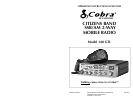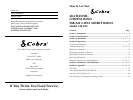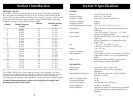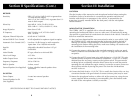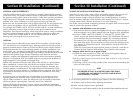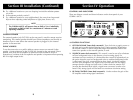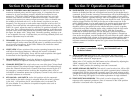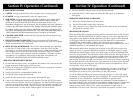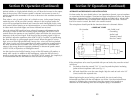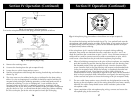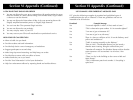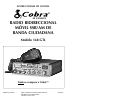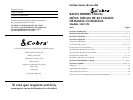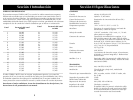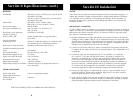
10
Section IV Operation (Continued)
4. SWR CAL CONTROL (outer dual concentric). In order for you to achieve
maximum radiated power and the longest range, it is important that your
antenna be in good condition, properly adjusted and matched to your
transceiver. The Built-in SWR (standing wave ratio) meter lets you easily
measure your antenna condition. To operate this function, connect your
antenna to the transceiver antenna output connector. Select a channel near
the middle of the band such as 21 or the channel you plan to use most
frequently. Turn the power on and set the meter function switch to the CAL
position. Press and hold the microphone push-to-talk button and using the
SWR CAL control, adjust the meter to read the CAL position indicated on the
meter face. Then, without releasing the microphone button, switch the meter
function switch to the SWR position and read the SWR indicated. The lower
the figure, the better, with 1 being ideal. Generally speaking, readings up to
3 are acceptable, but over 3 indicates that you are losing radiated power and
antenna adjustment may be advisable.
5. DYNAMIKE. Adjusts the microphone gain in the transmit and PA modes. This
controls the gain to the extent that full talk power is available several inches
away from the microphone. In the Public Address (PA) mode the control
functions as the volume control.
6. VOICE LOCK. Allows variation of the receiver operating frequencies above
and below the assigned frequency. Although this control is intended
primarily to tune in SSB signals, it may also be used to optimize AM signals
as described in the Operating Procedure paragraphs.
7. DIM/NOR/BRT SWITCH. Controls the brightness of the meter and LED
channel indicator for optimum intensity for day or night-time driving.
8. CHANNEL SELECTOR. This switch selects any one of the forty Citizens Band
channels desired. The selected channel appears on the LED readout directly
above the Channel Selector knob. Channel 9 has been reserved by the FCC
for emergency communications involving the immediate safety of life of
individuals or immediate protection of property. Channel 9 may also be used
to render assistance to a motorist.
9. 0FF/ANL/NB + ANL SWITCH. In the ANL position only the automatic
noise limiter in the audio circuits is activated. When the switch is placed
in the ANL + NB position, the RF noise blanker also is activated. The
RF noise blanker is very effective for repetitive impulse noise such as
ignition interference.
11
Section IV Operation (Continued)
10. PA/CB SWITCH. Selects the mode of operation. In the CB position, the PA
function is disabled and the unit will transmit and receive on the speaker that is
connected. In the PA mode, incoming CB transmission will be heard through the
PA speaker. This allows you to monitor messages while outside of your vehicle.
To use the PA feature, a speaker having a voice coil impedance of 8 ohms and
a power handling capability of at least three watts should be used. This speaker
must be plugged into the PA SPKR jack at the rear of the transceiver. If the
public address feature is to be used primarily for outdoor applications, the use
of a weatherproof horn type public address speaker is recommended. The
durability of this type speaker plus the inherent efficiency of such a speaker
will provide more than adequate results when combined with the high audio
output level available from the COBRA 148GTL. With the PA speaker
connected as outlined previously, be sure that there is physical separation
between the microphone and the speaker itself. If the speaker is located too
close to the microphone, acoustic feedback will result when the public address
system is operated at high volume. A directional type outdoor speaker reduces
the amount of isolation required. Some experimentation will determine the
minimum amount of isolation required for a given sound level from the public
address system.
NOTE
PA volume is controlled by adjusting the DYNAMIKE knob to
the desired volume.
11. S-RF/CAL/SWR SWITCH. When in the S-RF position, the meter swings
proportionally to the strength of the received signal. When transmitting, the
meter indicates relative RF output power.
When in the “CAL” position, the SWR meter can be calibrated by adjusting the
“SWR” control to the “CAL” mark on the meter face.
When in “SWR” position, the standing wave ratio is measured.
12. MODE (LSB/AM/USB) SWITCH. This switch is used to select AM, LSB or USB
mode of operation. Unless the station with which communication is desired is
equipped with SSB, the AM mode is normally used. The mode selector switch
changes the mode of operation of both transmitter and receiver simultaneously.
Turn to “Receiving SSB signals” for a further explanation of single sideband.
13. TONE SWITCH-HI/NOR/LOW. This switch is used to shape the audio
response to the operator’s preference. Bass is increased in the LOW position
and treble is increased in the HI position.



